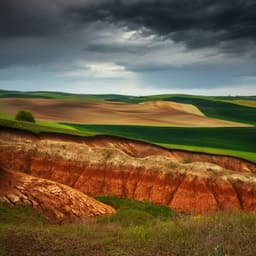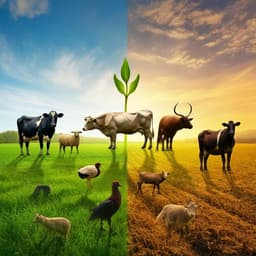
Environmental Studies and Forestry
Climate and land management accelerate the Brazilian water cycle
V. B. P. Chagas, P. L. B. Chaffe, et al.
This groundbreaking study by Vinícius B. P. Chagas, Pedro L. B. Chaffe, and Günter Blöschl reveals how increased water use and deforestation have intensified the impacts of climate change on streamflow extremes across South American tropical river basins over the last four decades, posing risks to global carbon sequestration and food security.
~3 min • Beginner • English
Introduction
Floods and droughts cause more damage worldwide than any other natural hazard and their risks may be exacerbated by climate change and socio-economic activities. While increases in floods often coincide with decreases in droughts under more abundant rainfall (and vice versa), some models suggest a joint increase in the severity of both, referred to as acceleration of the terrestrial water cycle. Multiple processes may drive acceleration: warming increases atmospheric moisture capacity enhancing extreme rainfall and potentially floods; increased rainfall seasonality may deepen hydrological droughts; changes in large-scale circulation (e.g., stationary waves, monsoons) can intensify persistent wet and dry periods. Land management (agriculture, river engineering, urbanization, groundwater pumping) can increase overland flow and reduce groundwater recharge, amplifying both floods and droughts. There is little observation-based evidence of acceleration over land due to data limitations and human interference. This study addresses the research gap by evaluating, at continental scale in Brazil, the relative roles of climate variability and land management (water use and deforestation) in changing streamflow extremes over the past four decades.
Literature Review
The paper synthesizes prior work indicating globally increasing risks of floods and droughts and the possibility of compound events. Theoretical and observational studies link warming to increased extreme precipitation and altered seasonality, and circulation changes such as amplified stationary waves and monsoon shifts. Over oceans, evidence exists for intensifying water cycle, whereas land-based evidence is scarcer. Land management impacts on hydrology are well documented: reduced infiltration and groundwater recharge under agriculture, effects of river engineering, urbanization, and groundwater abstraction. In South America, previous studies examined climate-driven and land-use-driven streamflow changes separately, including shifts in SACZ and ITCZ, ENSO influences, and Amazonian deforestation effects on hydrology and rainfall. This study integrates these strands by jointly attributing observed streamflow trends to climatic and anthropogenic drivers across Brazil.
Methodology
Study area and data: Daily streamflow from 886 hydrometric stations across Brazil (CAMELS-BR) for 1980–2015, filtered to ensure at least 25 years of data, records starting before 1990 and ending after 2005, and excluding basins with >10% urban cover or regulation >25%. Catchment areas: 11–5,120,000 km² (median 2,080 km²). Climate data: precipitation from CHIRPS v2.0 (0.05°, 1981–2015), evaporation (including transpiration) from GLEAM v3.3a (0.05°, 1980–2015), with ERA5-Land tested as alternative. Land data: ESA/CCI Land Cover v2.0 (300 m, 1992–2015), aggregated to native vegetation (forests, shrublands, grasslands, sparse vegetation, wetlands). Water use: monthly consumptive water use by Brazilian municipality (1931–2015) from ANA, mapped to 500 m grid and aggregated to basins; categories include irrigation, livestock, households, industry, mining, and power plant cooling (reservoir evaporation not included). Water use outside Brazil not considered.
Variables and units: For each station, annual series computed for: minimum 7-day streamflow (drought flows), mean daily streamflow, maximum daily streamflow (flood flows); climate drivers: mean daily P−E, minimum 90-day P−E, maximum 14-day P−E; non-climatic drivers: native vegetation cover (% basin area), consumptive water use. All hydrometeorological variables in mm d⁻¹ independent of basin size; native vegetation in %; water use normalized by long-term mean daily streamflow.
Trend estimation: Local linear trend magnitudes via Theil–Sen slope; significance via Mann–Kendall with trend-free pre-whitening for significant lag-1 autocorrelation. Trends expressed as % per decade by dividing slope by series long-term mean (exceptions: native vegetation as percentage points per decade; water use normalized by streamflow). Example: Madeira River drought flow trend −0.00588 mm d⁻¹ yr⁻¹ over mean 0.4398 mm d⁻¹ gives −13.4% per decade. Robustness checks include alternative P−E windows (min 60–120 days; max 7–30 days) and using 5th/95th percentiles instead of 7-day minimum and daily maximum flows.
Spatial interpolation: Regional trends obtained via ordinary block kriging (gstat) using best-fit variograms on 4°×4° blocks (~445×445 km). Robustness tested with block sizes 1°–6° and spatial thinning of stations (>0.5° and >1° separation), yielding similar patterns (Spearman ≥0.93). Regional trend uncertainties from kriging errors; local trend uncertainties via bootstrapping.
Attribution via panel regressions: Fixed-effects panel regressions with logarithmic-transformed variables (except vegetation in %) to relate drought flows ln(Qmin) to ln(mean P−E), ln(min P−E), ln(water use), and vegetation; and flood flows ln(Qmax) to ln(mean P−E), ln(max P−E), ln(water use), and vegetation. Native vegetation terms were non-significant in 1992–2015 and were removed; final regressions used 1980–2015. Robust standard errors used (plm, sandwich, lmtest in R). Coefficients interpreted as elasticities.
Quadrant classification of change: Joint classification of regional trends in drought and flood flows into wetting (both positive), drying (both negative), accelerating (drought down, flood up), decelerating (drought up, flood down). A 2D histogram of regional trends was used to map average driver trends per bin. Expected quadrant frequencies computed for a standardized bivariate normal with correlation ρ=0.61.
Return period changes: Nonstationary GEV fitted to annual maxima and (negated) minima with location parameter μ varying linearly with time (μ_t=a+bt). Parameters estimated via Bayesian MCMC (DREAM(ZS)); 12,000 posterior samples used to compute how a 100-year flood (in 1980) and a 10-year drought (in 1980) changed in return period by 2015. Medians reported with uncertainty (90% CI).
Key Findings
- Widespread and heterogeneous streamflow changes across Brazil: regional drought-flow trends range from −37% to +16% per decade; flood-flow trends from −17% to +10% per decade. Average over all stations: droughts −5%/decade; floods −1%/decade. Among 886 stations, significant (α=0.05) trends: drought flows decreased at 353 stations and increased at 56; flood flows decreased at 104 and increased at 51.
- Attribution: Drought-flow trends are primarily associated with changes in mean daily P−E and minimum P−E, with substantial negative effects from increasing water use, especially in central-eastern Brazil. Flood changes relate to maximum 14-day P−E and mean P−E, indicating sensitivity to extreme precipitation and antecedent wetness.
- Hotspots: Southern Brazil and northern Amazonia show increases in both drought and flood flows aligned with increasing mean and extreme P−E; limited land-management impacts. Brazilian Highlands (intensive agriculture) show declining drought flows linked to decreasing mean P−E and rapidly increasing water use (post-2000 decoupling from mean P−E). Southern Amazonia shows substantial decreases in drought flows with little change in climatic drivers, implicating large-scale deforestation.
- Quadrant classification: 29% of Brazil exhibits an accelerating water cycle (increasing floods, decreasing drought flows), 4% decelerating, 42% drying, and 25% wetting. The spatial correlation between regional drought and flood trends is ρ=0.61. Accelerating coverage (29%) is roughly double the 15% expected from a standardized bivariate normal with ρ=0.61.
- Drivers by quadrant: Mean P−E trends average +5%/decade in wetting regions and −3%/decade in drying regions. Increased water use amplifies drying; virtually all areas with water use increases >+0.5% of long-term mean flow per decade fall in the drying quadrant. The accelerating quadrant is dominated by increasing maximum P−E (+2%/decade on average) and decreasing native vegetation cover; 60% of areas with native vegetation loss >2 percentage points per decade are in the accelerating quadrant.
- Large-scale climate context: Drying in central and NE Brazil linked to southward shift of SACZ and northward displacement of ITCZ; expansion of irrigated agriculture (15 to 70 thousand km² from 1980 to 2015; +367%) increased consumptive use (68% of national water use in 2017), especially during May–September dry season. Wetting in northern Amazonia associated with ITCZ shifts; wetting in southern Brazil linked to stronger ENSO effects and SACZ changes. Southern Amazonia acceleration linked to intensified Walker circulation (North Atlantic warming, tropical Pacific cooling) and deforestation-driven land degradation reducing infiltration and baseflow while increasing runoff and possibly extreme convection.
- Risk amplification: In the Brazilian Highlands (drying quadrant), the 10-year drought in 1980 now recurs about every 1 year (90% CI 1, 2). In Amazonia (accelerating quadrant), the average 100-year flood in 1980 has become approximately a 25-year flood by 2015 (90% CI 5, 190).
- Implications: Increased drought risk threatens agricultural productivity and global food security; increased flood risk challenges infrastructure and hydropower development (most Amazonian potential untapped). Enhanced flooding and droughts may increase tree mortality in floodplain forests, reduce Amazonian carbon sink capacity (currently ~0.4 Pg C yr⁻¹ sequestration), reduce moisture recycling, and raise risk of forest dieback tipping points.
Discussion
The study demonstrates that observed changes in Brazilian streamflow extremes are jointly driven by climate variability and land management, directly addressing the central question of the relative contributions to streamflow change. Drying patterns coincide with declining mean water balance (P−E) and rising consumptive water use, highlighting how agricultural expansion and irrigation intensify hydrological droughts beyond climatic drying. Accelerating behavior—simultaneous increases in flood severity and drought severity—is linked to increased extremes in P−E and widespread deforestation, especially in southern Amazonia where land degradation reduces infiltration and baseflow while enhancing storm runoff. These findings indicate that human land and water use amplify climate-driven hydroclimatic variability, moving substantial regions into higher compound risk of both floods and droughts. The results are regionally coherent and robust to methodological choices, and they align with known shifts in large-scale circulation (SACZ, ITCZ, Walker circulation). The implications are significant: increased compound risks threaten food security, infrastructure safety (including hydropower planning), and ecosystem resilience (Amazonian carbon sink and forest health). The quadrant framework provides an actionable lens for regional risk management and for benchmarking Earth System models to attribute joint extremes to climate, deforestation, and water use.
Conclusion
Brazil has experienced widespread, nonuniform changes in streamflow extremes over the past four decades: 42% of the area shows drying, 25% wetting, and notably 29% an accelerating water cycle with both intensified floods and droughts. Drought-flow declines are primarily linked to reductions in mean P−E compounded by rising consumptive water use, while flood increases are tied to increases in extreme P−E and antecedent wetness. In southern Amazonia, deforestation and land degradation likely amplify acceleration, reducing low flows and increasing high flows. These observation-based results reveal that land management and water use can substantially amplify climate-driven changes. Future work should extend observation-based mapping globally, refine attribution using Earth System models that jointly represent climate, deforestation, and water use, and develop integrated mitigation and adaptation strategies. Coordinated climate mitigation and adaptive land and water management are essential to reduce compound risks to food security, infrastructure, and ecosystems.
Limitations
- Water use estimates exclude evaporation losses from reservoirs and do not cover areas outside Brazil (notably parts of western Amazonia), potentially underestimating anthropogenic impacts in some basins.
- Gauge network density is lower in the Amazon, increasing interpolation uncertainty; despite robustness checks, regional kriging introduces spatial uncertainty.
- Native vegetation effects were not significant in panel regressions over 1992–2015, possibly due to data limitations, spatial heterogeneity, or model structure; however, vegetation loss emerged as important in the quadrant analysis.
- Trend analyses rely on gridded precipitation (CHIRPS) and evaporation (GLEAM) products; while validated against stations and alternatives (MSWEP, ERA5-Land), product uncertainties remain.
- Exclusion of strongly urbanized or regulated basins improves large-scale inference but limits generalizability to highly engineered systems.
- Study period ends in 2015; subsequent land-use changes and climate variability are not captured.
Related Publications
Explore these studies to deepen your understanding of the subject.







